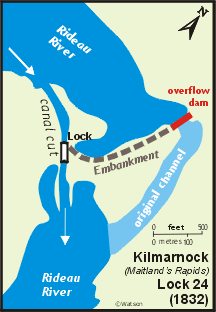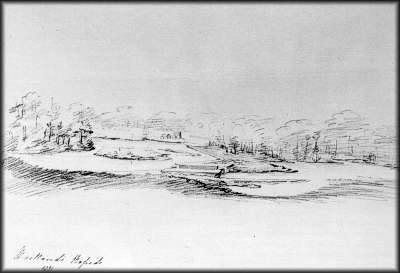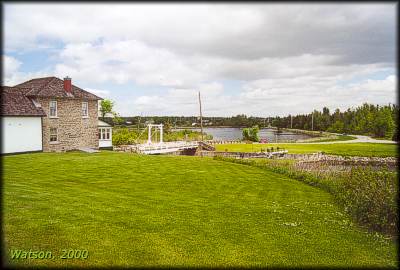Kilmarnock Lock 24
(original name: Maitland's Rapids)
| location map | lockstation information |
The Setting
The main channel of the Rideau at this location took a sharp turn around the end of what is now known as Kilmarnock Island. The rapids at this bend of the river were known as Maitland's Rapids, named after James Maitland, a former sergeant in the 90th Regiment, who had settled there prior to the canal being built. It was noted in the initial surveys that the rapids were short and not very swift. It was also noted that there were many shoals in the river all the way up to Edmunds.
The Plan
The original plan was to take advantage of a snie (dry flood channel) that cut across the bend of the river, and place a small dam across the main channel of the River at the rapids. The dam would raise the river to deepen the water at Edmund's shallows and to drown a small rapid in between. A lock with a lift of four feet (1.2 m) would be placed in the centre of the snie.
Building the Locks
The contractor for this site was Edward W. Thompson.
 A number of problems arose quite early on. During the clearing of the land and subsequent surveys, it was discovered that there was a low swampy area, not noted in the original survey, where water would escape once the dam was put in place. Another problem was that a horrendous smell was released by decayed vegetable matter as the mud was excavated. In addition, large boulders scattered throughout the mud made for difficult digging To make a bad situation worse, malaria, then known as "swamp fever" hit in the summer of 1828. This was blamed on the foul air emanating from the mud and many men refused to work. A number of problems arose quite early on. During the clearing of the land and subsequent surveys, it was discovered that there was a low swampy area, not noted in the original survey, where water would escape once the dam was put in place. Another problem was that a horrendous smell was released by decayed vegetable matter as the mud was excavated. In addition, large boulders scattered throughout the mud made for difficult digging To make a bad situation worse, malaria, then known as "swamp fever" hit in the summer of 1828. This was blamed on the foul air emanating from the mud and many men refused to work.
In By's 1830 report he stated, "In commencing the works in the Snie, the effluvia arising from disturbing the soil was so offensive, and of such a malignant nature as to occasion great sickness, so much so, that the Labourers refused to Continue the necessary Clearing and Grubbing which had been partly executed; it was also ascertained that the deepening of the Snie in question would have attend with a much heavier expense than foreseen, for instead of Soft Mud the removal of which was Estimated at £194, the Excavation required proved to Consist of very large Boulders more difficult from their hard Nature to remove, than Solid Rock, a much greater extent of Excavation was also required than provided for in the Estimate given to the Committee, arising from the necessity of Cutting off Points in the Snie, and the additional width required in order to form direct Entrances for Steam Boats into the Lock."
By's solution to these problems was to lower the height of the dam and the lift of the lock by 2 feet (0.6 m), and run an embankment from the upper wing wall of the lock, across to the dam. He moved the location of the canal cut away from the centre of the snie to the edge, in order to allow excavation in rock rather than mud. He also had the river channel deepened upstream to provide proper navigation depth.
The lock was built with wooden sills anchored to the bedrock floor. The dam and waste weir were built of wood. The total lift of the lock was 2 feet (0.6 m), the smallest lift of any lockstation on the Rideau. This allowed Colonel By to do away with the breastwork and tunnel sluices, speeding up construction.
A small back dam was built on the far (south) side of Kilmarnock Island, across a marshy stretch, to prevent the raised water from escaping around that side of the island.
In 1832 a rolling bridge was built across the lock.
In the early 1840s, a defensible stone lockmaster's house, 27 feet (8.2 m) square, was built.
 |
Maitland's Rapids; 1832
John Burrows, pencil sketch, Archives of Ontario
The single lock at Maitland’s Rapids (now known as Kilmarnock). Behind the lock is the embankment stretching over to an overflow weir. The two buildings on the other side of the weir belong to James Maitland. |
Through the Years
The lockstation was referred to as Maitland's Lock until about 1866, when the name Kilmarnock became the more common name. Kilmarnock was the name of the village that sprung up in this location when the lock was completed.
The lock itself faired well over the years, requiring just the usual maintenance for general wear and tear. The original wooden sills of the lock were replaced with concrete. The timber dam and waste weir were also rebuilt in concrete.
The problem in this area was with the back dam, on the other side of Kilmarnock Island, which controlled the water level in the marshy reach upstream to Edmunds. The dam, which was initially no more than a heap of stones, was damaged several times by local residents trying to lower the water level to drain land for agricultural use. In addition, local fishermen were also known to dig channels through the structure so that they could haul their boats from one level to the other.
In order to alleviate some of the problems with the navigation channel above Kilmarnock, the bedrock of the channel was blasted down another two feet in 1899-1900. This still didn't solve the problems experienced with the back dam and in 1913-1914 extensive repairs were made to the dam to make it more durable and watertight.
The lockmaster's house had a second masonry storey added to it early in the 20th century. At that time the loopholes in the original structure were filled in with masonry.
An unequal arm, center bearing timber swing bridge replaced the original rolling bridge across the lock in 1871. That bridge has been replaced with bridges of the same design several times since initial installation.
 |
Kilmarnock
photo by: Ken Watson, 2000
Looking north (same view as Burrows painting). Visible are the two storey lockmaster's house, timber swing bridge, and a now overgrown embankment (fronting the road). The top of the lower lock gates are just barely visible. |
The Lockmasters to 2000
The first lockmaster was James Maitland, a former sergeant in the 90th Regiment. He was By's recommended appointment. Maitland had settled in this area prior to the construction of the canal and he had made no claim for compensation for his land that was used by the canal. He served until retirement in 1846. He was succeeded by George Newsome, who was retired in 1871. He was replaced by his son, William Newsome who became the longest serving lockmaster on the Rideau, retiring after 50 years of service in 1921. He was followed by J. R. Dalton, from 1922 to 1941; Fred Dawe, 1942 to 1945, R.V. Marshall from 1946 to 1964; Ted Moncriff from 1965 to 1977; unknown from 1978 to 1980; Stan Irvin from 1980 to 1995. The lockmaster position was combined with Edmunds in 1995 and Ron Hyland served as lockmaster from 1995 to 2000.
|